
New signs on I-75 help steer drivers to faraway places
Engineer adds points of interest
6/5/2017
A sign on I-75 southbound between Perrysburg and Bowling Green lets travelers know that Atlanta is just 652 miles away, if anyone was wondering just how far the Georgia city is.
THE BLADE/ANDY MORRISON
Buy This Image
BOWLING GREEN — Signs along southbound I-75 in Wood County used to tell motorists how far it was to Dayton or Cincinnati, along with the mileage to the next exit.
But when new mileage signs were posted last year, a few different places were included.
Along with listing 12 miles to Bowling Green and 193 to Cincy, a sign just south of the I-475 junction in Perrysburg offers, “Atlanta 652.”
The next one, after the State Rt. 582 interchange near Dunbridge, reads “Dayton 133, Lexington 268, Tampa 1103.”
RELATED: Road Warrior 6/5
Credit the geography lesson to Chris Waterfield, district traffic engineer at the Ohio Department of Transportation’s district office in Bowling Green, who decided to mix things up a bit — while complying with federal sign guidelines — when he designed new signs five years ago to be erected after I-75’s recent widening south of Perrysburg.
“This is my attempt at maybe trying to wake you up a little bit, and see something different. I don’t think you need to see the same thing every five miles. I want to make it interesting,” Mr. Waterfield said.
The three-line signs do not cost significantly more than the two-line standard ODOT signs used for mileage, he said.
Consistent among the signs is that the top line is used for mileage to “the next meaningful exit,” Mr. Waterfield said, while acknowledging that’s “a really subjective thing.”
On northbound I-75 after North Baltimore, Mr. Waterfield decided the State Rt. 25 exit at Cygnet was not “meaningful,” so the mileage sign there lists the U.S. 6 interchange south of Bowling Green on the top line. Southbound out of Perrysburg, the State Rt. 582 interchange at Dunbridge is similarly ignored.
For the middle line he had a little more leeway, opting in several cases to list Toledo suburbs on the northbound side and intermediate towns on the southbound side that other signs had left out.
Mr. Waterfield said the inclusion of Wapakoneta on one of the southbound signs was done after consultation with ODOT’s neighboring district office in Lima, while several Toledo suburbs appear on the northbound side.
“I made sure to include Rossford on one of the signs,” the sign engineer confirmed, acknowledging that city’s complaint a decade ago that it got short shrift on I-75 signage.
For the farthest cities, Mr. Waterfield said he consulted a list of the 100 biggest United States cities and then chose the ones along I-75.
Knoxville and Chattanooga, Tenn., didn’t make the top 100, or they might have appeared on a sign, he said, while higher-ups nixed the idea of listing Miami — I-75’s southern terminus — on one.
That may have been because most people traveling from Ohio would not drive I-75 all the way to Miami, and Mr. Waterfield cited that reasoning for why he didn’t use Flint or Sault Ste. Marie, Mich., on northbound mileage signs.
“I skipped Sault Ste. Marie because drivers would probably use U.S. 23” north out of Toledo to go there, he explained, so it would be unclear whether mileage listed should be via I-75 or via the more direct U.S. 23 route.
There is a sign on I-75 in North Toledo listing mileage to Flint, he added, because at that point a driver is “committed” to taking I-75 to get there.
Rebecca Shirling, ODOT’s district spokesman, said the office has received “two or three phone calls” and an inquisitive Twitter message.
“I’m glad people are actually paying attention to the signs,” Mr. Waterfield said.
The I-75 signs follow the lead of similar faraway mileages posted in other parts of the country.
On westbound I-70 west of Baltimore, the Maryland Department of Transportation has a sign listing mileages to Columbus, St. Louis, Denver, and Cove Fort, Utah — the latter being I-70’s west end at a remote junction with I-15.
Ocean City, Md., and Sacramento, Calif., have complementary signs reporting the 3,073 miles between those cities on U.S. 50, as do Bishop, Calif., and Provincetown, Mass., 3,205 miles apart on U.S. 6.
While similar signs on the Ohio Turnpike could list distant cities along I-90 or I-80, however, don’t expect to see a “Seattle 2280” or “San Francisco 2356” sign on the westbound turnpike west of I-75 any time soon — just Chicago or, eastbound, Cleveland, Youngstown, or Pittsburgh.
“There are no such plans on the Ohio Turnpike,” said spokesman Brian Newbacher. “It would be hard to say with certainty that the idea was never considered, but it’s safe to say that it is not on the drawing board.”
Matt Bruning, a spokesman at ODOT’s Columbus headquarters, gave a similar response to prospects for distant-city mileages on other Ohio interstates.
While “the signs on I-75 are fun, there doesn’t appear to be a push to expand the practice statewide,” he said. “That’s not to say one of our other districts couldn’t do it, but it’s not likely that you’ll start seeing a lot more of these popping up all across Ohio.”
Contact David Patch at: dpatch@theblade.com or 419-724-6094.